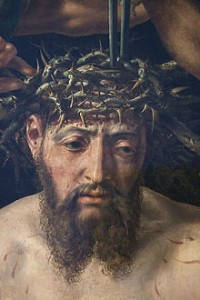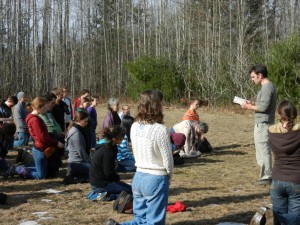I met an acquaintance recently, and he asked to write a brief blurb for him on what was wrong with the modern university, and why we were trying to start a new, but actually old, kind of ‘university’ here at Our Lady Seat of Wisdom. I thought, well, there are different ways one could describe the motives behind our endeavour here, so thought I would write a column to air my own thoughts, and so that a few other people might read the response.
The modern university may be described in one word, drawn from a poem by T.S. Eliot to sum up modern man’s condition in general: Hollow. Like the gilded parties and the characters in F. Scott Fitzgerald’s The Great Gatsby, universities are all glitz and show on the outside, but empty and barren on the inside.
When one tours a modern campus, when one flips through their impressive, thick academic calendars, when one glances at the glossy brochures and webpages, filled with photogenic co-eds, the feeling of euphoria and exciting potential, a series of halcyonic tomorrows, is hard to resist. I was there once…
But my advice is that resist it one must, for, like a Potemkin village, there is not much reality behind the showy exterior. Whatever reason one has for attending the modern university (and I will discuss briefly later whether there are any), I will break down its shortcomings in three sections: Intellectual, moral and spiritual.
Intellectual formation should be the main task of a university, to educate and perfect the mind. When one sets out on such an endeavour, or indeed any task, one should ask, as Aristotle does, what is one’s intention or purpose? In the present case, we must ask, what does it mean to ‘form the mind’?
Education implies at least two things: Teaching the person how to think, as well as what he should know. These are two related tasks, which should coalesce in every course taught. The student should be immersed in the great books of our civilization, its history and thought; however, he should also learn, by the principles of philosophy, logic, as well as faith, how to criticize and evaluate what he learns. As G.K. Chesterton wisely said, the task of education may be boiled down to the attempt to ‘form good critics’ which, in the Greek sense of ‘critic’ means to judge rightly between truth and falsity, good and evil.
To do this, a university has to be aware of, and committed to, objective truth. Here we see the main difference between the modern and the classical university. As Pope Benedict XVI put it, we live under a ‘tyranny of relativism’, an outright denial of any objective truth. The classical university, whether Catholic or not, believed that there was a truth that could be sought, appropriated and handed down through the ages. It was this truth that gave the guiding principle to the university itself.
Catholics believe not only in natural truth, but supernatural truth that has been revealed by God through Christ and His Church. These revealed truths, the investigation of which we call ‘theology’, are not only the only truths that are consistently true, guarded by the charism of infallibility, but they are also the most important truths, dealing with man’s final supernatural end, and the means to attain this end (the life of grace and prayer and the moral life). That is why, as the Church herself implies, a university must not only be Catholic (and it was the Church which founded the first universities in the 12th century), but must also, as Blessed Cardinal Newman wrote in his classic treatise Idea of a University, have theology as its core discipline, which has been described as the ‘queen of the sciences’.
This is not to turn the university into a seminary or a monastery; rather, theology is taught in such a way that it gives light and direction to all the other courses: Philosophy, history, literature, logic, natural science, art and music. The student, following such a curriculum based on the perfection of faith and reason, becomes deeply and broadly educated in truth, in all of its manifestations. This process is captured in its essence in Pope Saint John Paul II’s masterful encyclical Fides et Ratio, as well as in more practical detail in the Apostolic Constitution on the Catholic Univeristy Ex Corde Ecclesiae.
Once this solid and broad foundation has been achieved, then, if so desired, the student can specialize in further studies or in a trade or follow some other vocational path.
The modern secular university, on the other hand, asks the student to specialize right after high school, to choose a ‘major’ from the gargantuan academic calendar. He focuses on this narrow range of studies, which are usually taught in a largely historical, statistical, mathematical way, avoiding any reference to objective truth (excepting certain science and engineering courses, which, by definition, must have some objective truth at their basis, such as the stress-quotient of various materials, and the function of organ systems in the body: We don’t want our bridges falling down!). This narrow range of studies only increases as the student proceeds in his discipline.
(I need not mention vapid courses in ‘queer studies’ or ‘gender theory’ and their ilk, which begin and end with false premises, and are an exercise in futility).
To add insult to injury, the courses are often taught by sessional teachers or graduate students, who have little or no experience, no job security, and receive minimal remuneration. Full professors teach only minimally, usually upper-year or graduate courses, and spend most of their time in research and writing (after all, the motto is publish or perish, to ensure one’s career advancement, for the attaining of the coveted tenure depends much more on one’s publication record than on what one has taught, or, even less, one’s teaching ability). Witness the current debacle at York University, where the plethora of such underpaid teachers are now on strike, demanding pay, security and benefits more in line with the full-time professors. We may be seeing the first cracks in the breakdown of the current university system, Deo volente.
Now to the question of morality: Does an educational institution have an obligation to morally form its students? The modern university has answered in the negative, and we see the consequences: The encouragement, or at least passive tolerance, of unrestrained sexual activity, dormitories with young men and women living side by side, sharing bathrooms, and with no rules on pre-marital sexual relations of any kind, provided they are deemed ‘consensual’ (although even this is now raising numerous legal issues, as I wrote previously). Binge drinking and incipient alcoholism are tacitly encouraged, not formally by the university, but certainly by vocal and influential elements of the student body.
The underlying problem is that the modern university offers no objective moral standard towards which to strive, except perhaps a vague ‘tolerance’. One can safely conclude that if one becomes morally formed during these years of education, it is in spite of, not because of, life at the modern university.
Finally, there is spiritual formation. As I wrote previously, man is by nature a spiritual and a religious being, based on what we choose to make the ‘master of our affections’, as Saint Thomas puts it. The modern university, although often founded by religious institutes, has become, as a whole, avowedly agnostic if not outright atheistic and antagonistic to religion. There is no prayer on campus, no liturgy to speak of, no common mission to any transcendent principle. (I prescind here from the Catholic colleges which do have chapels and liturgies but, sadly, are under the thumb of their parent universities, blend almost imperceptibly into the larger campus, and cannot help but be affected in an adverse way. Perhaps I will write on them later).
All in all, to develop spiritually at the modern university, with some felicitous exceptions, requires finding most of one’s spiritual growth with various off-campus groups. One will most certainly not find it in one’s courses; in fact, they are, as a whole, following their atheistic metaphysical foundation, anti-spiritual, at least in any Catholic sense.
My wonder is that people actually pay money for this. We are now seeing a posteriori the fruit of the crisis in our universities, as a Bachelor of Arts and Science, once a coveted degree, is rapidly losing its cachet and are now a dime a dozen. Of course, since our universities are publicly subsidized here in Canada, I as a taxpayer am forced to fund this mis-education of our future generations. But I wonder about parents, especially those of a more moral, spiritual and intellectual bent, entrusting their children to an environment that, to a greater or lesser extent, will malform their children, especially in the sensitive years as they leave the parental home and forge themselves into young adults, all the while trying to discern their vocations.
I suppose one could use the modern university to get a functional degree in law, medicine, computer science and so on, the so-called STEM studies (science, technology, engineering and mathematics). These, as I alluded earlier, are the least affected by false philosophy, and are still taught with a degree of rigour and truth, albeit limited to the horizon of the material and practical. But do we want to produce a whole generation of technically proficient, but undereducated, automatons who can scarcely think for themselves, who have little or no knowledge of history, philosophy, and literature, to say nothing of the teachings of the Church? We are forgetting, not just as individuals but as an entire society, whence we come, and whither we go, the ‘why’ of it all.
After my own time at one of the ‘modern universities’ years ago (and they have only declined since then, as far as I can discern), I now understand why the graduates of this system will vote for Justin Trudeau, why they still praise his father as a ‘great Canadian’, why they see nothing wrong with abortion, nor with the recent ruling allowing physicians to kill their patients, and why they have no answer to radical Islam, nor, in fact, to any philosophical or theological error. We are losing our capacity to think critically, in conformity with objective truth and reality and, as a result, as Pope John Paul II lamented in Evangelium Vitae (20 years ago this March!), we are developing the “darkest moral blindness”, and “reverting to a state of barbarism which one hoped had been left behind forever”.
 As usual, to end on at least one sign of hope, amongst many: We here at Our Lady Seat of Wisdom are doing what we can, in our own humble way, to build a classical university in the Catholic tradition, so we may once again recapture the original ‘idea of a university’, and educate students in a truly integral way, body, soul and mind. To find out more on how we are striving to do this, please browse our webpage. We are always looking for supporters, material and spiritual, and for students who see the value in our mission. For, as the Second Vatican Council Pastoral Constitution, Gaudium et Spes (Joy and Hope!) warned, the world stands in peril unless wiser men are forthcoming.
As usual, to end on at least one sign of hope, amongst many: We here at Our Lady Seat of Wisdom are doing what we can, in our own humble way, to build a classical university in the Catholic tradition, so we may once again recapture the original ‘idea of a university’, and educate students in a truly integral way, body, soul and mind. To find out more on how we are striving to do this, please browse our webpage. We are always looking for supporters, material and spiritual, and for students who see the value in our mission. For, as the Second Vatican Council Pastoral Constitution, Gaudium et Spes (Joy and Hope!) warned, the world stands in peril unless wiser men are forthcoming.
March 13, 2015
Anniversary of the Election of Pope Francis
 As we begin the most solemn time of year we call Holy Week, leading up to the great Triduum, Holy Thursday, Good Friday, and Holy Saturday, bringing us to the high point of the liturgical year at Easter, we should reflect more intensely on the humanity of Christ and His suffering, through which He gained our redemption.
As we begin the most solemn time of year we call Holy Week, leading up to the great Triduum, Holy Thursday, Good Friday, and Holy Saturday, bringing us to the high point of the liturgical year at Easter, we should reflect more intensely on the humanity of Christ and His suffering, through which He gained our redemption.









